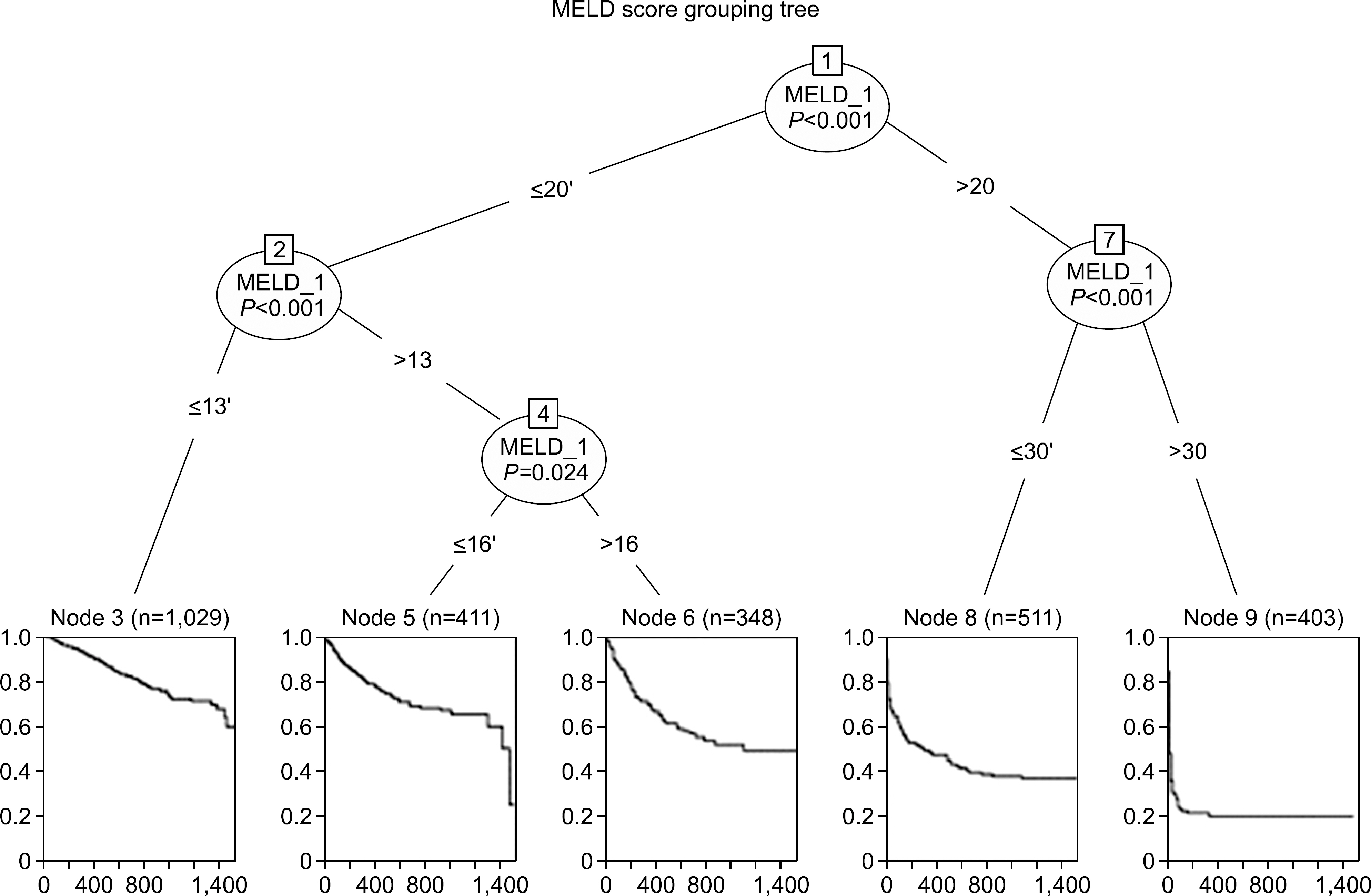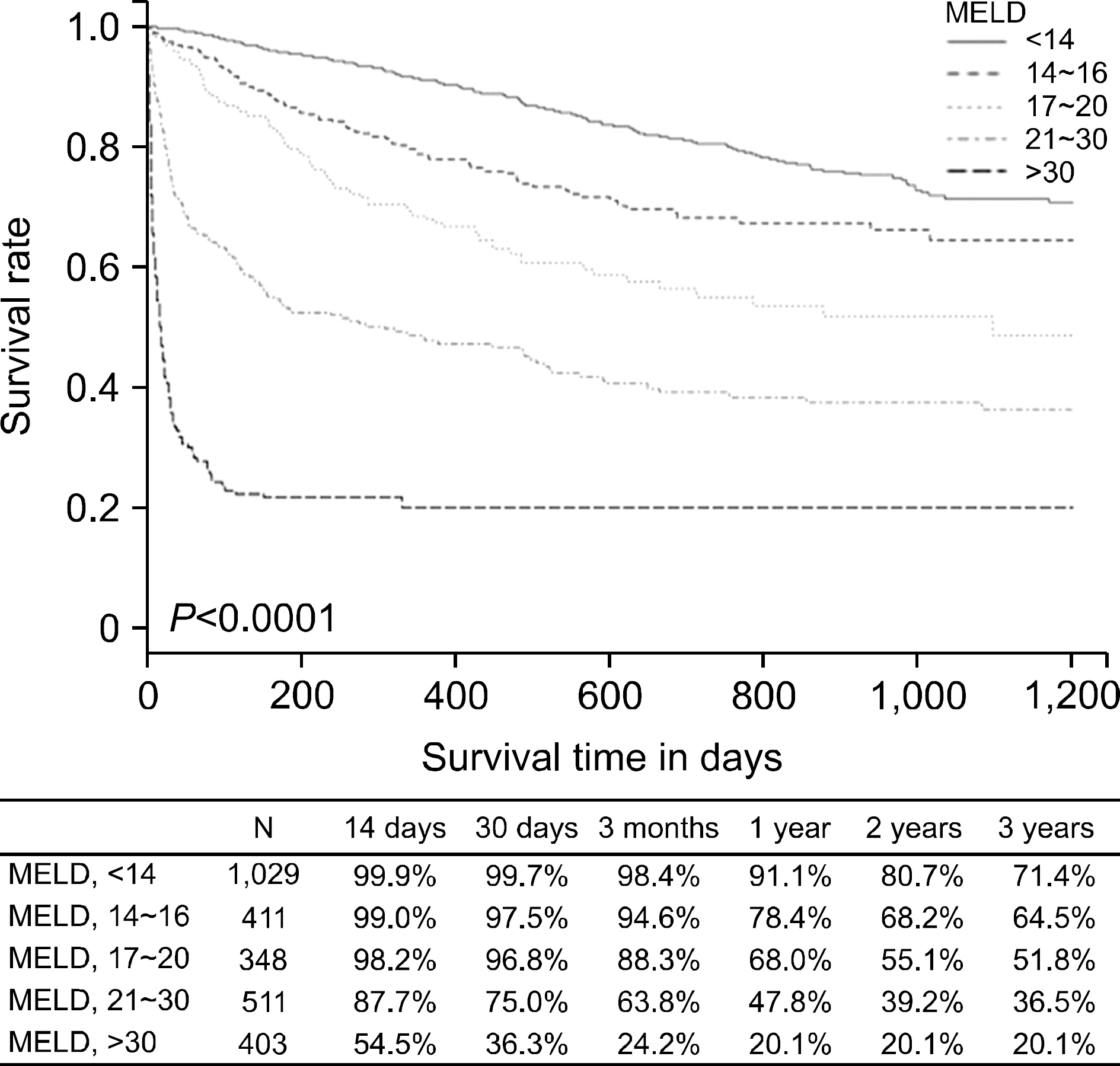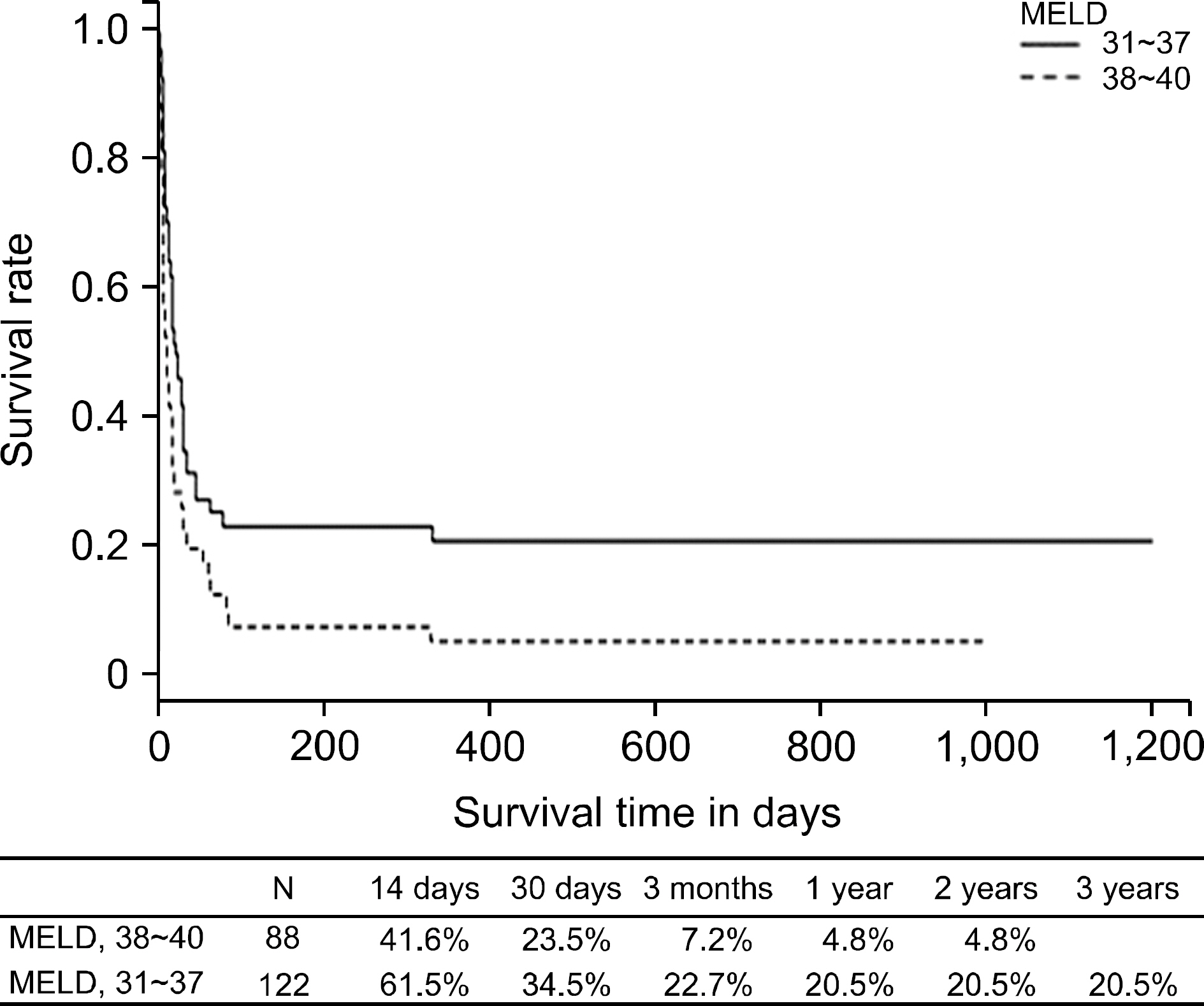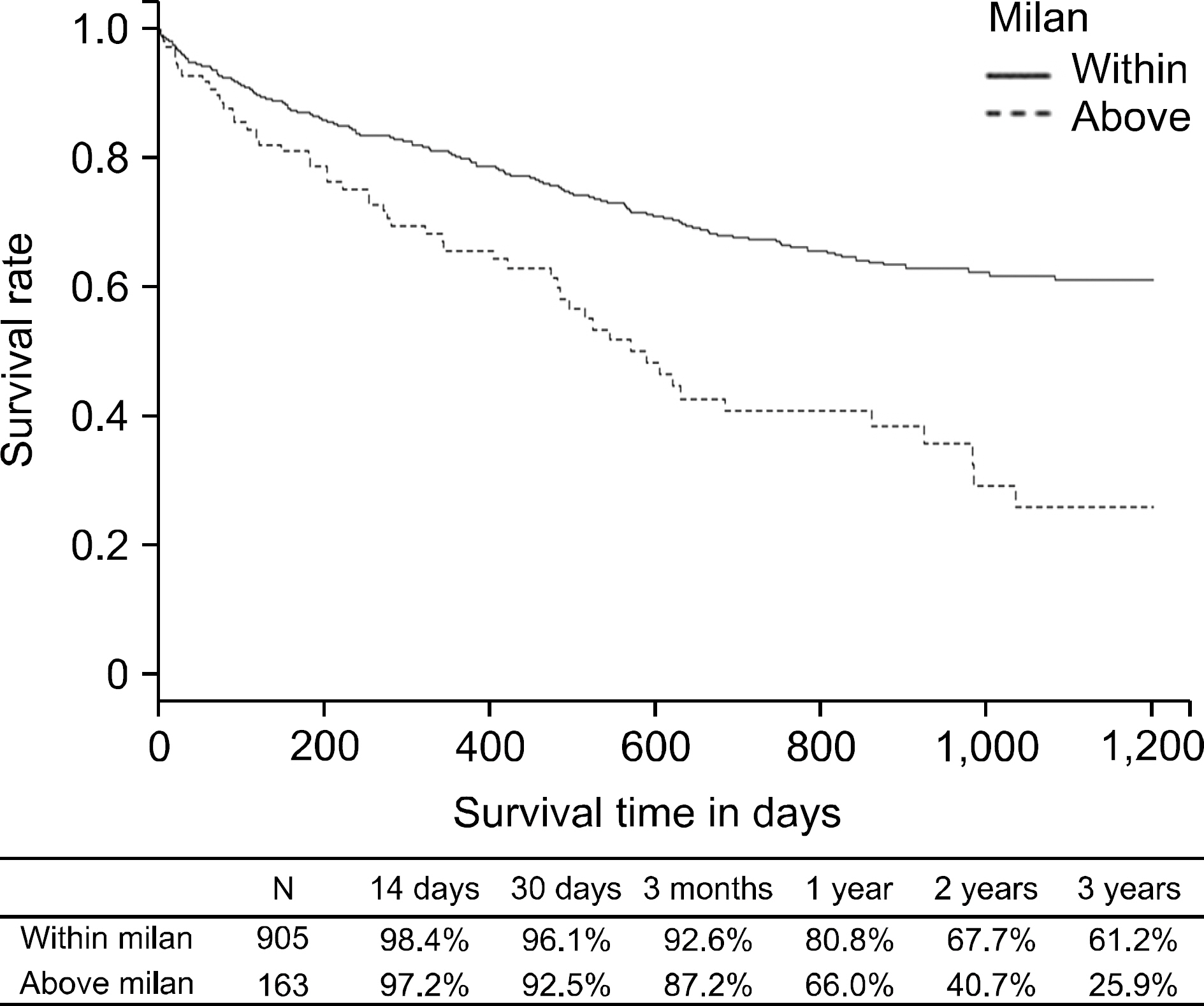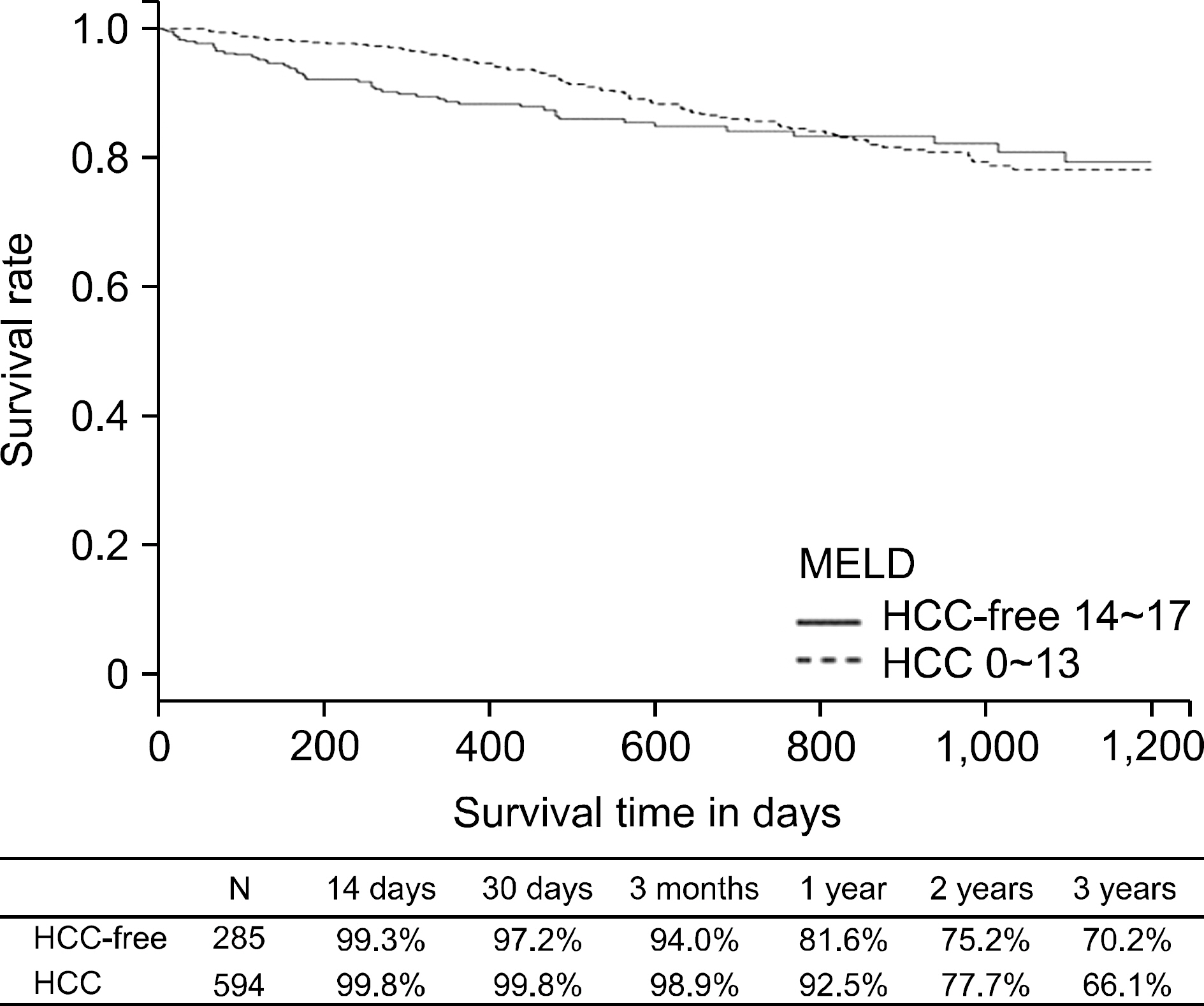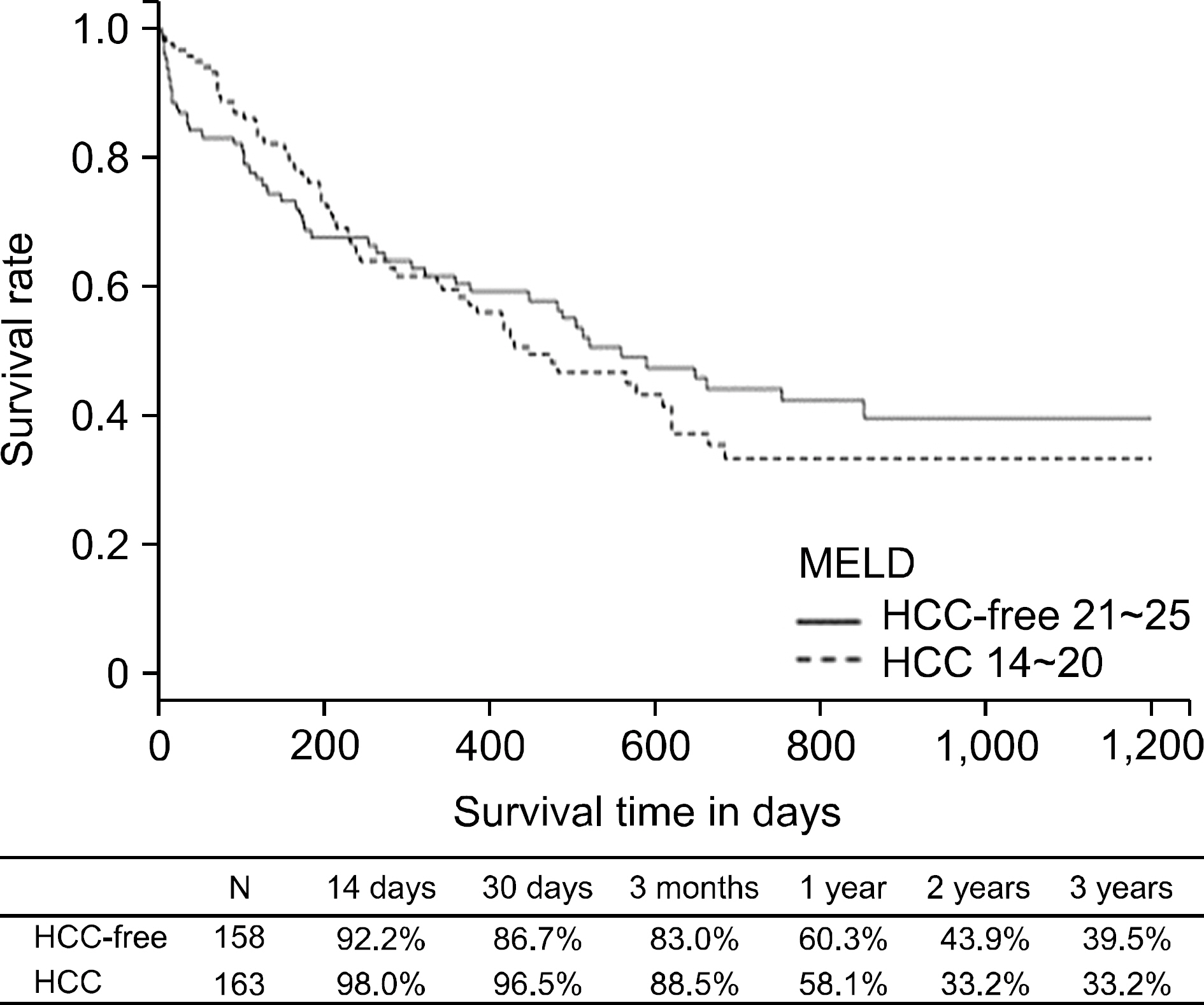Modification of Emergency Status in Deceased Donor Liver Allocation: Evidence for Korean Model of End-stage Liver Disease (MELD) System
- Affiliations
-
- 1Department of Surgery, Yonsei University College of Medicine, Seoul, Korea. ysms91@yuhs.ac
- 2The Research Institute for Transplantation, Yonsei University College of Medicine, Seoul, Korea.
- KMID: 2327963
- DOI: http://doi.org/10.4285/jkstn.2016.30.2.51
Abstract
- For a more useful and objective allocation system, we considered the Model for End-stage Liver Disease (MELD) system as an alternative to the Child-Turcotte-Pugh (CTP) score and status system in Korea. Development of basic assessment measures based on the Korean health service environment is the objective of this study. The data collected from a series of liver transplant candidates (n=2,702, 2009~2012) were used as raw data for statistical analysis for this study. Using MELD score cut-points at 20, 30, 38 points, we observed significant survival difference by step-wise survival analysis. Emergency status 2 (38~40 points) and status 3 (31~37 points) were classified as urgent status for liver allocation. In such classes, early national-based allocation is possible. Patients with hepatocellular carcinoma (HCC) with low MELD scores (<20 point) are given an additional MELD score (+4 or +5 MELD score). This study helps advance the development of basic systematic rules for liver allocation. The rules for management of registration and re-registration of status, registration interval, validity and treatment rule of non-registered cases are defined. Through analysis of Korean retrospective records, this study proposed basic rules of liver allocation and a systematic proposal for the MELD system, which has been in use since June 2016.
Keyword
MeSH Terms
Figure
Cited by 7 articles
-
Current Status of Deceased Donor Liver Transplantation for Alcoholic Liver Disease in Korea in MELD Era
Dong Jin Joo
Korean J Gastroenterol. 2021;77(1):4-11. doi: 10.4166/kjg.2020.167.Outcome of patients with severe alcoholic hepatitis after Model for End-Stage Liver Disease-based allocation system implementation in Korea
Tae Jin Kwon, Wonseok Kang, Geum-Youn Gwak, Yong-Han Paik, Moon Seok Choi, Joon Hyeok Lee, Kwang Cheol Koh, Dong Hyun Sinn, Seung Woon Paik
Korean J Transplant. 2021;35(1):24-32. doi: 10.4285/kjt.20.0054.Prognosis of hepatic epithelioid hemangioendothelioma after living donor liver transplantation
Byeong-Gon Na, Shin Hwang, Chul-Soo Ahn, Ki-Hun Kim, Deok-Bog Moon, Tae-Yong Ha, Gi-Won Song, Dong-Hwan Jung, Gil-Chun Park, Young-In Yoon, Woo-Hyoung Kang, Hwui-Dong Cho, Sang Hoon Kim, Seung-Mo Hong, Sung-Gyu Lee
Korean J Transplant. 2021;35(1):15-23. doi: 10.4285/kjt.20.0049.The impact of Model for End-Stage Liver Disease score on deceased donor liver transplant outcomes in low volume liver transplantation center: a retrospective and single-center study
Doo-Ho Lee, Yeon Ho Park, Seok Won Choi, Kug Hyun Nam, Sang Tae Choi, Doojin Kim
Ann Surg Treat Res. 2021;101(6):360-367. doi: 10.4174/astr.2021.101.6.360.Comparison Study of Outcomes of Deceased Donor Liver Transplantation before and after Korean Model for End-Stage Liver Disease (MELD) System: Single Center Experience
Ji A Lee, Gyu-seong Choi, Jong Man Kim, Chun Hyuck David Kwon, Jae-Won Joh
J Korean Soc Transplant. 2018;32(1):7-11. doi: 10.4285/jkstn.2018.30.1.07.Mortality scoring systems for liver transplant recipients: before and after model for end-stage liver disease score
Yang-Hoon Chung, Jaewoong Jung, Sang Hyun Kim
Anesth Pain Med. 2023;18(1):21-28. doi: 10.17085/apm.22258.Ventilator support in the pretransplant period predisposes early graft failure after deceased donor liver transplantation
Nuri Lee, Sora Cha, Jongman Kim, Yunmi Lee, Enjin Kang, Hyun Jung Kim, Seung Hui Hong, Jinsoo Rhu, Gyu-Seong Choi, Jae-Won Joh
Ann Surg Treat Res. 2023;105(3):141-147. doi: 10.4174/astr.2023.105.3.141.
Reference
-
1). Korean Network for Organ Sharing (KONOS). Korean law and regulation related with organ donation and transplantation [Internet]. Seoul: KONOS;2013. [cited 2014 Nov 5]. Available from:. http://www.konos.go.kr.2). Wiesner RH., McDiarmid SV., Kamath PS., Edwards EB., Malinchoc M., Kremers WK, et al. MELD and PELD: application of survival models to liver allocation. Liver Transpl. 2001. 7:567–80.
Article3). Malinchoc M., Kamath PS., Gordon FD., Peine CJ., Rank J., ter Borg PC. A model to predict poor survival in patients undergoing transjugular intrahepatic portosystemic shunts. Hepatology. 2000. 31:864–71.
Article4). Santori G., Andorno E., Morelli N., Antonucci A., Bottino G., Mondello R, et al. MELD score versus conventional UNOS status in predicting short-term mortality after liver transplantation. Transpl Int. 2005. 18:65–72.
Article5). Dutkowski P., Oberkofler CE., Béchir M., Müllhaupt B., Geier A., Raptis DA, et al. The model for end-stage liver disease allocation system for liver transplantation saves lives, but increases morbidity and cost: a prospective outcome analysis. Liver Transpl. 2011. 17:674–84.
Article6). Cywinski JB., Mascha EJ., You J., Sessler DI., Kapural L., Argalious M, et al. Pre-transplant MELD and sodium MELD score are poor predictors of graft failure and mortality after liver transplantation. Hepatol Int. 2011. 5:841–9.7). Korean Network for Organ Sharing (KONOS). 2013 Annual data report [Internet]. Seoul: KONOS;2013. [cited 2014 Nov 5]. Available from:. http://www.konos.go.kr.8). Kim MS., Kim SI., Kim YS. Current status of deceased donor organ recovery and sharing in Korea. J Korean Med Assoc. 2008. 51:685–91. (김명수, 김순일, 김유선. 뇌사자 발생과 뇌사 자 장기 분배의 국내현황. 대한의사협회지 2008;51: 685-91.).
Article9). Joo DJ., Kim MS., Kim SI., Jeon KO., Huh KH., Choi GH, et al. Severity of end-stage liver disease in liver transplant candidate; comparison of KONOS status with MELD score. J Korean Soc Transplant. 2012. 26:112–9. (주동진, 김명수, 김순일, 전경옥, 허규하, 최기홍, 등. 뇌사자 간이식에서 이식 대기자의 응급도 평가지표로서 KONOS 응급도와 MELD 점수와 의 비교. 대한이식학회지 2012;26: 112-9.).
Article10). Hong G., Lee KW., Suh SW., Yoo T., Kim H., Park MS., Choi Y., Yi NJ., Suh KS. The model for end-stage liver disease score-based system predicts short term mortality better than the current child-turcotte-pugh score-based allocation system during waiting for deceased liver transplantation. J Korean Med Sci. 2013. 28:1207–12.
Article11). Kim MS., Lee KW., Whang S., Kwon CHD., You YK., Nah YW, et al. Research for modification of emergency status in deceased donor liver allocation - survival analysis of waiting patients for liver transplantation. J Korean Soc Transplant. 2014. 28:59–68. (김명수, 이광웅, 황신, 권준혁, 유 영경, 나양원, 등. 간장 응급도 기준 개선방안 연구: 간이식 대기자 의 생존분석. 대한이식학회지2014;28: 59-68.).12). Hothorn T., Hornik K., Zeileis A. Unbiased recursive partitioning: a conditional inference framework. J Comput Graph Stat. 2006. 15:651–74.
Article13). Organ Procurement and Transplantation Network (OPTN). Redesigning liver distribution to reduce variation in access to liver transplantation [Internet]. Washington, D.C.: U.S. Department of Health & Human Services;2014. [cited 2014 Nov 20]. Available from:. http://optn.transplant.hrsa.gov.14). Organ Procurement and Transplantation Network (OPTN). Organ Procurement and Transplantation Network (OPTN) policies [Internet]. Washington, D.C.: U.S. Department of Health & Human Services;2014. [cited 2014 Aug 10]. Available from:. http://optn.transplant.hrsa.gov.15). Organ Procurement and Transplantation Network (OPTN). Proposal for regional distribution of livers for critically ill candidates [Internet]. Washington, D.C.: U.S. Department of Health & Human Services;2014. [cited 2014 Oct 10]. Available from:. http://optn.transplant.hrsa.gov.16). Mazzaferro V., Regalia E., Doci R., Andreola S., Pulvirenti A., Bozzetti F, et al. Liver transplantation for the treatment of small hepatocellular carcinomas in patients with cirrhosis. N Engl J Med. 1996. 334:693–9.
Article17). Freeman RB Jr., Gish RG., Harper A., Davis GL., Vierling J., Lieblein L, et al. Model for end-stage liver disease (MELD) exception guidelines: results and recommendations from the MELD Exception Study Group and Conference (MESSAGE) for the approval of patients who need liver transplantation with diseases not considered by the standard MELD formula. Liver Transpl. 2006. 12(12 Suppl 3):S128–36.
Article18). Cheng SJ., Freeman RB Jr., Wong JB. Predicting the probability of progression-free survival in patients with small hepatocellular carcinoma. Liver Transpl. 2002. 8:323–8.
Article
- Full Text Links
- Actions
-
Cited
- CITED
-
- Close
- Share
- Similar articles
-
- Current Status of Deceased Donor Liver Transplantation for Alcoholic Liver Disease in Korea in MELD Era
- Impact of Model for End-Stage Liver Disease allocation system on outcomes of deceased donor liver transplantation: A single-center experience
- Comparison Study of Outcomes of Deceased Donor Liver Transplantation before and after Korean Model for End-Stage Liver Disease (MELD) System: Single Center Experience
- Deceased donor liver transplantation under Korean MELD score-based liver allocation system at a high-volume transplantation center
- Outcome of patients with severe alcoholic hepatitis after Model for End-Stage Liver Disease-based allocation system implementation in Korea

